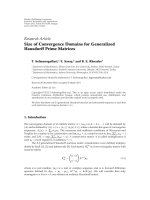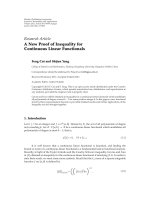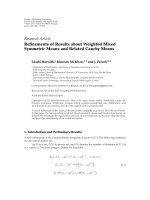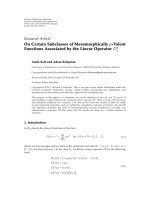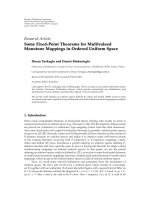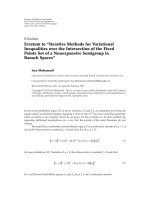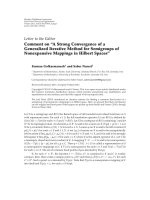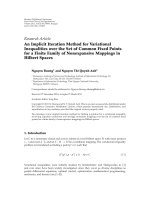Hindawi Publishing Corporation Advances in Difference Equations Volume 2010, Article ID 127093, 11 pdf
Bạn đang xem bản rút gọn của tài liệu. Xem và tải ngay bản đầy đủ của tài liệu tại đây (504.64 KB, 11 trang )
Hindawi Publishing Corporation
Advances in Difference Equations
Volume 2010, Article ID 127093, 11 pages
doi:10.1155/2010/127093
Research Article
On the Existence of Locally Attractive
Solutions of a Nonlinear Quadratic Volterra
Integral Equation of Fractional Order
Mohamed I. Abbas
Department of Mathematics, Faculty of Science, Alexandria University, Alexandria, Egypt
Correspondence should be addressed to Mohamed I. Abbas, m
i
Received 19 May 2010; Accepted 25 November 2010
Academic Editor: Mouffak Benchohra
Copyright q 2010 Mohamed I. Abbas. This is an open access article distributed under the Creative
Commons Attribution License, which permits unrestricted use, distribution, and reproduction in
any medium, provided the original work is properly cited.
The authors employs a hybrid fixed point theorem involving the multiplication of two operators
for proving an existence result of locally attractive solutions of a nonlinear quadratic Volterra
integral equation of fractional arbitrary order. Investigations will be carried out in the Banach
space of real functions which are defined, continuous, and bounded on the real half axis
.
1. Introduction
The theory of differential and integral equations of fractional order has recently received a
lot of attention and now constitutes a significant branch of nonlinear analysis. Numerous
research papers and monographs have appeared devoted to differential and integral
equations of fractional order cf., e.g., 1–6. These papers contain various types of existence
results for equations of fractional order.
In this paper, we study the existence of locally attractive solutions of the following
nonlinear quadratic Volterra integral equation of fractional order:
x
t
f
t, x
t
q
t
1
Γ
α
t
0
g
t, s, x
s
t − s
1−α
ds
, 1.1
for all t ∈
and α ∈ 0, 1, in the space of real functions defined, continuous, and bounded
on an unbounded interva l.
2AdvancesinDifference Equations
It is worthwhile mentioning that up to now integral equations of fractional order have
only been studied in the space of real functions defined on a bounded interval. The result
obtained in this paper generalizes several ones obtained earlier by many authors.
In fact, our result in this paper is motivated by the extension of the work of Hu and
Yan 7. Also, We proceed and generalize the results obtained in the papers 8, 9.
2. Notations, Definitions, and Auxiliary Facts
Denote by L
1
a, b the space of Lebesgue integrable functions on the interval a, b,which
is equipped with the standard norm. Let x ∈ L
1
a, b and let α>0 be a fixed number. The
Riemann-Liouville fractional integral of order α of the function xt is defined by the formula:
I
α
x
t
1
Γ
α
t
0
x
s
t − s
1−α
ds, t ∈
a, b
,
2.1
where Γα denotes the gamma function.
It may be shown that the fractional integral operator, I
α
transforms the space L
1
a, b
into itself and has some other properties see 10–12.
Let X BC
be the space of continuous and bounded real-valued functions on
and let Ω be a subset of X.LetP : X → X be an operator and consider the following operator
equation in X,namely,
x
t
Px
t
, 2.2
for all t ∈
. Below we give different characterizations of the solutions for the operator
equation 2.2 on
. We need the following definitions in the sequel.
Definition 2.1. We say that solutions of 2.2 are locally attractive if there exists an x
0
∈ BC
and an r>0 such that for all solutions x xt and y yt of 2.2 belonging to B
r
x
0
∩ Ω
we have that:
lim
t →∞
x
t
− y
t
0.
2.3
Definition 2.2. An operator P : X → X is called Lipschitz if there exists a constant k such that
Px − Py≤kx − y for all x, y ∈ X. The constant k is called the Lipschitz constant of P on
X.
Definition 2.3 Dugundji and Granas 13.AnoperatorP on a Banach space X into itself is
called compact if for any bounded subset S of X, PS is a relatively compact subset of X.If
P is continuous and compact, then it is called completely continuous on X.
We seek the solutions of 1.1 in the space BC
of continuous and bounded real-
valued functions defined on
. Define a standard supremum norm ·and a multiplication
“·”inBC
by
x
sup
{|
x
t
|
: t ∈
}
,
xy
t
x
t
y
t
,t∈
. 2.4
Advances in Difference Equations 3
Clearly, BC
becomes a Banach space with respect to the above norm and the
multiplication in it. By L
1
we denote the space of Lebesgue integrable functions on
with the norm ·
L
1
defined by
x
L
1
∞
0
|
x
t
|
dt. 2.5
We employ a h ybrid fixed point theorem of Dhage 14 for proving the existence result.
Theorem 2.4 Dhage 14. Let S be a closed-convex and bounded subset of the Banach space X and
let F, G : S → S be two operators satisfying:
a F is Lipschitz with the Lipschitz constant k,
b G is completely continuous,
c FxGx ∈ S for all x ∈ S,and
d Mk < 1 where M GS sup{Gx : x ∈ S}.
Then the operator equation
FxGx x 2.6
has a solution and the set of all solutions is compact in S.
3. Existence Result
We consider the following set of hypotheses in the sequel.
H1 The function f :
× → is continuous, and there exists a bounded function
l :
→
with bound L sa tisfying
f
t, x
− f
t, y
≤ l
t
x − y
3.1
for all t ∈
and x, y ∈ .
H2 The function f
1
:
→ defined by f
1
|ft, 0| is bounded with
f
0
sup
f
1
t
: t ∈
. 3.2
H3 The function q :
→
is continuous and lim
t →∞
qt0.
H4 The function g :
×
× → is continuous. Moreover, there exist a function
m :
→
being continuous on
and a function h :
→
being continuous
on
with h00andsuchthat
g
t, s, x
− g
t, s, y
≤ m
t
h
x − y
3.3
for all t, s ∈
such that s ≤ t and for all x, y ∈ .
4AdvancesinDifference Equations
For further purposes let us define the function g
1
:
→
by putting
g
1
t
max
g
t, s, 0
:0≤ s ≤ t
. 3.4
Obviously the function g
1
is continuous on
.
In what follows we will assume additionally that the following conditions are
satisfied.
H5 The functions a, b :
→
defined by the formulas
a
t
m
t
t
α
,b
t
g
1
t
t
α
, 3.5
are bounded on
and vanish at infinity, that is, lim
t →∞
atlim
t →∞
bt0.
Remark 3.1. Note that if the hypotheses H3 and H5 hold, then ther e exist constants K
1
> 0
and K
2
> 0suchthat:
K
1
sup
q
t
: t ∈
,K
2
sup
a
t
h
r
b
t
Γ
α 1
: t, r ∈
. 3.6
Theorem 3.2. Assume that the hypotheses H1–H5 hold. Furthermore, if LK
1
K
2
< 1,where
K
1
and K
2
are defined in Remark 3.1,then1.1 has at least one solution in the space BC
.
Moreover, solutions of 1.1 are locally attractive on
.
Proof. Set X BC
, . Consider the closed ball B
r
0 in X centered at origin 0 and of
radius r,wherer f
0
K
1
K
2
/1 − LK
1
K
2
> 0.
Let us define two operators F and G on B
r
0 by
Fx
t
f
t, x
t
,
Gx
t
q
t
1
Γ
α
t
0
g
t, s, x
s
t − s
1−α
ds,
3.7
for all t ∈
.
According to the hypothesis H1, the operator F is well defined and the function
Fx is continuous and bounded on
. Also, since the function q is continuous on
,the
function Gx is continuous and bounded in view of hypothesis H4. Therefore F and G define
the operators F, G : B
r
0 → X. We will show that F and G sa tisfy the requirements of
Theorem 2.4 on B
r
0.
The operator F is a Lipschitz operator on B
r
0.Infact,letx, y ∈ B
r
0 be arbitrary.
Then by hypothesis H1,weget
Fx
t
− Fy
t
f
t, x
t
− f
t, y
t
≤ l
t
x
t
− y
t
≤ L
x − y
, 3.8
Advances in Difference Equations 5
for all t ∈
. Taking the supremum over t,
Fx − Fy
≤ L
x − y
, 3.9
for all x, y ∈ B
r
0. This shows that F is a Lipschitz on B
r
0 with the Lipschitz constant L.
Next, we show that G is a continuous and compact operator on B
r
0. First we show
that G is continuous on B
r
0. To do this, let us fix arbitrary >0andtakex, y ∈ B
r
0 such
that x − y≤.Thenweget
Gx
t
−
Gy
t
≤
1
Γ
α
t
0
g
t, s, x
s
− g
t, s, y
s
t − s
1−α
ds
≤
1
Γ
α
t
0
m
t
h
x
s
− y
s
t − s
1−α
ds
≤
m
t
t
α
Γ
α 1
h
r
≤
a
t
Γ
α 1
h
r
.
3.10
Since hr is continuous on
, then it is bounded on
, and ther e exists a nonnegative
constant, say h
∗
,suchthath
∗
sup{hr : r>0}. Hence, in view of hypothesis H5,we
infer that there exists T>0suchthatat ≤ Γα 1/h
∗
for t>T.Thus,fort>Twe derive
that
Gx
t
−
Gy
t
≤ . 3.11
Furthermore, let us assume that t ∈ 0,T. Then, evaluating similarly to the above we obtain
the following estimate:
Gx
t
−
Gy
t
≤
1
Γ
α
t
0
g
t, s, x
s
− g
t, s, y
s
t − s
1−α
ds ≤
T
α
Γ
α 1
ω
T
r
g,
,
3.12
where ω
T
r
g,sup{|gt, s, x − gt, s, y| : t, s ∈ 0 ,T, x, y ∈ −r, r, |x − y|≤}.
Therefore, from the uniform continuity of the function gt, s, x on the set 0,T ×
0,T × −r, r we derive that ω
T
r
g, → 0as → 0. Hence, from the above-
established facts we conclude that the operator G maps the ball B
r
0 continuously into
itself.
6AdvancesinDifference Equations
Now, we show that G is compact on B
r
0. It is enough to show that every sequence
{Gx
n
} in GB
r
0 has a Cauchy subsequence. In view of hypotheses H3 and H4,we
infer that:
|
Gx
n
t
|
≤
q
t
1
Γ
α
t
0
g
t, s, x
n
s
t − s
1−α
ds
≤
q
t
1
Γ
α
t
0
g
t, s, x
n
s
− g
t, s, 0
t − s
1−α
ds
1
Γ
α
t
0
g
t, s, 0
t − s
1−α
ds
≤
q
t
1
Γ
α
t
0
m
t
h
|
x
n
s
|
t − s
1−α
ds
1
Γ
α
t
0
g
1
t
t − s
1−α
ds
≤
q
t
m
t
t
α
Γ
α 1
h
r
g
1
t
t
α
Γ
α 1
≤
q
t
a
t
h
r
b
t
Γ
α 1
≤ K
1
K
2
,
3.13
for all t ∈
. Taking the supremum over t,weobtainGx
n
≤K
1
K
2
for all n ∈ .This
shows that {Gx
n
} is a uniformly bounded sequence in GB
r
0. We show that it is a lso
equicontinuous. Let >0 be given. Since lim
t →∞
qt0, there is constant T>0suchthat
|qt| </2forallt ≥ T.
Let t
1
,t
2
∈
be arbitrary. If t
1
,t
2
∈ 0,T,thenwehave
|
Gx
n
t
2
− Gx
n
t
1
|
≤
q
t
2
− q
t
1
1
Γ
α
t
2
0
g
t
2
,s,x
n
s
t
2
− s
1−α
ds −
t
1
0
g
t
1
,s,x
n
s
t
1
− s
1−α
ds
≤
q
t
2
− q
t
1
1
Γ
α
t
1
0
g
t
2
,s,x
n
s
t
2
− s
1−α
ds
t
2
t
1
g
t
2
,s,x
n
s
t
2
− s
1−α
ds
t
1
0
g
t
1
,s,x
n
s
t
1
− s
1−α
ds
≤
q
t
2
− q
t
1
1
Γ
α
t
1
0
g
t
2
,s,x
n
s
t
2
− s
1−α
−
g
t
1
,s,x
n
s
t
2
− s
1−α
ds
t
1
0
g
t
1
,s,x
n
s
t
2
− s
1−α
−
g
t
1
,s,x
n
s
t
1
− s
1−α
ds
t
2
t
1
g
t
2
,s,x
n
s
t
2
− s
1−α
ds
Advances in Difference Equations 7
≤
q
t
2
− q
t
1
1
Γ
α
t
1
0
g
t
2
,s,x
n
s
− g
t
1
,s,x
n
s
t
2
− s
1−α
ds
t
1
0
g
t
1
,s,x
n
s
1
t
2
− s
1−α
−
1
t
1
− s
1−α
ds
t
2
t
1
g
t
2
,s,x
n
s
t
2
− s
1−α
ds
≤
q
t
2
− q
t
1
1
Γ
α
t
1
0
g
t
2
,s,x
n
s
− g
t
1
,s,x
n
s
1
t
2
− s
1−α
ds
t
1
0
g
t
1
,s,x
n
s
− g
t
1
,s,0
g
t
1
,s,0
1
t
2
− s
1−α
−
1
t
1
− s
1−α
ds
t
2
t
1
g
t
2
,s,x
n
s
− g
t
2
,s,0
g
t
2
,s,0
t
2
− s
1−α
ds
≤
q
t
2
− q
t
1
1
Γ
α
t
1
0
g
t
2
,s,x
n
s
− g
t
1
,s,x
n
s
1
t
2
− s
1−α
ds
t
1
0
m
t
1
h
|
x
n
s
|
g
1
t
1
1
t
2
− s
1−α
−
1
t
1
− s
1−α
ds
t
2
t
1
m
t
2
h
|
x
n
s
|
g
1
t
2
t
2
− s
1−α
ds
≤
q
t
2
− q
t
1
1
Γ
α
t
1
0
g
t
2
,s,x
n
s
− g
t
1
,s,x
n
s
1
t
2
− s
1−α
ds
m
t
1
h
r
g
1
t
1
Γ
α 1
t
α
1
− t
α
2
t
2
− t
1
α
m
t
2
h
r
g
1
t
2
Γ
α 1
t
2
− t
1
α
.
3.14
From the uniform continuity of the function qt on 0,T and the function g in 0,T×
0,T × −r, r,weget|Gx
n
t
2
− Gx
n
t
1
|→0ast
1
→ t
2
.
If t
1
,t
2
≥ T,thenwehave
|
Gx
n
t
2
− Gx
n
t
1
|
≤
q
t
2
− q
t
1
1
Γ
α
t
2
0
g
t
2
,s,x
n
s
t
2
− s
1−α
ds −
t
1
0
g
t
1
,s,x
n
s
t
1
− s
1−α
ds
≤
q
t
1
q
t
2
1
Γ
α
t
2
0
g
t
2
,s,x
n
s
t
2
− s
1−α
ds −
t
1
0
g
t
1
,s,x
n
s
t
1
− s
1−α
ds
<,
3.15
as t
1
→ t
2
.
8AdvancesinDifference Equations
Similarly, if t
1
,t
2
∈
with t
1
<T<t
2
,thenwehave
|
Gx
n
t
2
− Gx
n
t
1
|
≤
|
Gx
n
t
2
− Gx
n
T
|
|
Gx
n
T
− Gx
n
t
1
|
. 3.16
Note that if t
1
→ t
2
,thenT → t
2
and t
1
→ T. Therefore from the above obtained estimates,
it follows tha t:
|
Gx
n
t
2
− Gx
n
T
|
−→ 0,
|
Gx
n
T
− Gx
n
t
1
|
−→ 0, as t
1
−→ t
2
. 3.17
As a result, |Gx
n
t
2
− Gx
n
T|→0ast
1
→ t
2
.Hence{Gx
n
} is an equicontinuous sequence
of functions in X. Now an application of the Arzel
´
a-Ascoli theorem yields that {Gx
n
} has
a uniformly convergent subsequence on the compact subset 0,T of
. Without loss of
generality, call the subsequence of the sequence itself.
We show that {Gx
n
} is Cauchy sequence in X.Now|Gx
n
t − Gxt|→0asn →∞
for all t ∈ 0,T. Then for given >0thereexistsann
0
∈ such that for m, n ≥ n
0
,thenwe
have
|
Gx
m
t
− Gx
n
t
|
1
Γ
α
t
0
g
t, s, x
m
s
− g
t, s, x
n
t
t − s
1−α
ds
≤
1
Γ
α
t
0
g
t, s, x
m
s
− g
t, s, x
n
t
t − s
1−α
ds
≤
1
Γ
α
t
0
m
t
h
|
x
m
s
− x
n
s
|
t − s
1−α
ds
≤
m
t
t
α
h
r
Γ
α 1
≤
a
t
h
∗
Γ
α 1
<.
3.18
This shows that {Gx
n
}⊂GB
r
0 ⊂ X is Cauchy. Since X is complete, then {Gx
n
} converges
to a point in X.AsGB
r
0 is closed, {Gx
n
} converges to a point in GB
r
0.Hence,
GB
r
0 is relatively compact and consequently G is a continuous and compact o perator on
B
r
0.
Advances in Difference Equations 9
Next, we show that FxGx ∈ B
r
0 for all x ∈ B
r
0.Letx ∈ B
r
0 be arbitrary, then
|
Fx
t
Gx
t
|
≤
|
Fx
t
||
Gx
t
|
≤
f
t, x
t
q
t
1
Γ
α
t
0
g
t, s, x
s
t − s
1−α
ds
≤
f
t, x
t
− f
t, 0
f
t, 0
q
t
1
Γ
α
t
0
g
t, s, x
s
− g
t, s, 0
g
t, s, 0
t − s
1−α
ds
≤
l
t
|
x
t
|
f
1
t
q
t
1
Γ
α
t
0
m
t
h
|
x
t
|
g
1
t
t − s
1−α
ds
≤
L
x
f
0
q
t
m
t
t
α
h
r
g
1
t
t
α
Γ
α 1
≤
L
x
f
0
q
t
a
t
h
r
b
t
Γ
α 1
≤
L
x
f
0
K
1
K
2
≤ L
K
1
K
2
x
f
0
K
1
K
2
f
0
K
1
K
2
1 − L
K
1
K
2
r,
3.19
for all t ∈
. Taking the supremum over t,weobtainFxGx≤r for all x ∈ B
r
0.Hence
hypothesis c of Theorem 2.4 holds.
Also we have
M
G
B
r
0
sup
{
Gx
: x ∈ B
r
0
}
sup
sup
t≥0
q
t
1
Γ
α
t
0
g
t, s, x
s
t − s
1−α
ds
: x ∈ B
r
0
≤ sup
t≥0
q
t
sup
t≥0
a
t
h
r
b
t
Γ
α 1
≤ K
1
K
2
,
3.20
and therefore Mk LK
1
K
2
< 1. Now we apply Theorem 2.4 to conclude that 1.1 has
asolutionon
10 Advances in Difference Equations
Finally, we show the local attractivity of the solutions for 1.1.Letx and y be any two
solutions of 1.1 in B
r
0 defined on
,thenweget
x
t
− y
t
≤
f
t, x
t
q
t
1
Γ
α
t
0
g
t, s, x
s
t − s
1−α
ds
f
t, y
t
q
t
1
Γ
α
t
0
g
t, s, y
s
t − s
1−α
ds
≤
f
t, x
t
q
t
1
Γ
α
t
0
g
t, s, x
s
t − s
1−α
ds
f
t, y
t
q
t
1
Γ
α
t
0
g
t, s, y
s
t − s
1−α
ds
≤ 2
Lr f
0
q
t
a
t
h
r
b
t
Γ
α 1
,
3.21
for all t ∈
. Since lim
t →∞
qt0, lim
t →∞
at0 and lim
t →∞
bt0, for >0, there are
real numbers T
> 0, T
> 0andT
> 0suchthat|qt| <for t ≥ T
, at <h
∗
/Γα 1 for
all t ≥ T
and bt </Γα 1 for all t ≥ T
. If we choose T
∗
max{T
,T
,T
}, then from the
above inequality it follows that |xt − yt|≤
∗
for t ≥ T
∗
,where
∗
6Lr f
0
>0. This
completes the proof.
4. An Example
In this section we provide an example illustrating the main existence result contained in
Theorem 3.2.
Example 4.1. Consider the following quadratic Volterra integral equation of fractional order:
x
t
t t
2
x
t
te
−t
2
/2
1
Γ
2/3
t
0
x
2/3
s
e
−3ts
1/
10t
8/3
1
t − s
1/3
ds
, 4.1
where t ∈
.
Observe that the above equation is a special case of 1.1.Indeed,ifweputα 2/3
and
f
t, x
t t
2
x,
q
t
te
−t
2
/2
,
g
t, s, x
x
2/3
s
e
−3ts
1
10t
8/3
1
.
4.2
Then we can easily check that the assumptions of Theorem 3.2 are satisfied. In fact, we
have that the function ft, x is continuous and satisfies assumption H1,whereltt
2
Advances in Difference Equations 11
and ft, 0 ft, 0t f
1
as in assumption H2. We have that the function qt is
continuous and it is easily seen that qt → 0ast →∞, thus assumption H3 is satisfied.
Next, let us notice that the function gt, s, x satisfies assumption H4,wheremte
−3t
,
hrr
2/3
and gt, s, 01/10t
8/3
1.Thusg
1
gt, s, 0. To check that assumption H5
is satisfied let us observe that the functions a, b appearing in that assumption take the form:
a
t
t
2/3
e
−3t
,b
t
t
2/3
10t
8/3
1
.
4.3
Thus it is easily seen that at,bt → 0ast →∞. Finally, let us note that in Remark 3.1
there are two constants K
1
,K
2
> 0suchthatLK
1
K
2
< 1. It is also easy to check that
K
1
q1e
−1/2
0.60653 , K
2
e
−3
0.1/0.8856 0.16913 and L 1. Then
LK
1
K
2
0.77566 < 1. Hence, taking into account that Γ5/3 > 0.8856 cf. 4,all
the assumptions of Theorem 3.2 are satisfied and 4.1 has a solution in the space BC
.
Moreover, solutions of 4.1 are uniformly locally attractive in the sense of Definition 2.1.
References
1 A. Babakhani and V. Daftardar-Gejji, “Existence of positive solutions of nonlinear fractional
differential equations,” Journal of Mathematical Analysis and Applications, vol. 278, no. 2, pp. 434–442,
2003.
2 M. M. El Borai, W. G. El-Sayed, and M. I. Abbas, “Monotonic solutions of a class of quadratic singular
integral equations of Volterra type,” International Journal of Contemporary Mathematical Sciences,vol.2,
no. 1–4, pp. 89–102, 2007.
3 M. M. El Borai and M. I. Abbas, “Solvability of an infinite system of singular integral equations,”
Serdica Mathematical Journal, vol. 33, no. 2-3, pp. 241–252, 2007.
4 M. M. El Borai and M. I. Abbas, “On some integro-differential equations of fractional orders involving
Carath
´
eodory nonlinearities,” International Journal of Modern Mathematics, vol. 2, no. 1, pp. 41–52, 2007.
5 S. G. Samko, A. A. Kilbas, and O. I. Marichev, Fractional Integrals and Derivatives: Theory and
Applications, Gordon and Breach, Yverdon, Switzerland, 1993.
6 H. M. Srivastava and R. K. Saxena, “Operators of fractional integration and their applications,”
Applied Mathematics and Computation, vol. 118, no. 1, pp. 1–52, 2001.
7 X. Hu and J. Yan, “The global attractivity and asymptotic stability of solution of a nonlinear integral
equation,” Journal of Mathematical Analysis and Applications, vol. 321, no. 1, pp. 147–156, 2006.
8 J. Bana
´
s and D. O’Regan, “On existence and local attractivity of solutions of a quadratic Volterra
integral equation of fractional order,” Journal of Mathematical Analysis and Applications, vol. 345, no. 1,
pp. 573–582, 2008.
9 B. Rzepka, “On attractivity and asymptotic stability of solutions of a q uadratic Volterra integral
equation of fractional order,” Topological Methods in Nonlinear Analysis, vol. 32, no. 1, pp. 89–102, 2008.
10 A. A. Kilbas and J. J. Trujillo, “Differential equations of fractional order: methods, results and
problems. I,” Applicable Analysis, vol. 78, no. 1-2, pp. 153–192, 2001.
11 K. S. Miller and B. Ross, An Introduction to the Fractional Calculus and Fractional Differential Equations,
John Wiley & Sons, New York, N Y, USA, 1993.
12 I. Podlubny, Fractional Differential Equations: An Introduction to Fractional Derivatives, Fractional
Differential Equations, to Methods of Their Solution and Some of Their Applications, vol. 198 of
Mathematics
in Science and Engineering, Academic Press, San Diego, Calif, USA, 1999.
13 J. Dugundji and A. Granas, Fixed Point Theory. I,vol.61ofMonografie Matematyczne,Pa
´
nstwowe
Wydawnictwo Naukowe, Warsaw, Poland, 1982.
14 B. C. Dhage, “Nonlinear functional boundary value problems in Banach algebras involving
Carath
´
eodories,” Kyungpook Mathematical Journal, vol. 46, no. 4, pp. 527–541, 2006.
